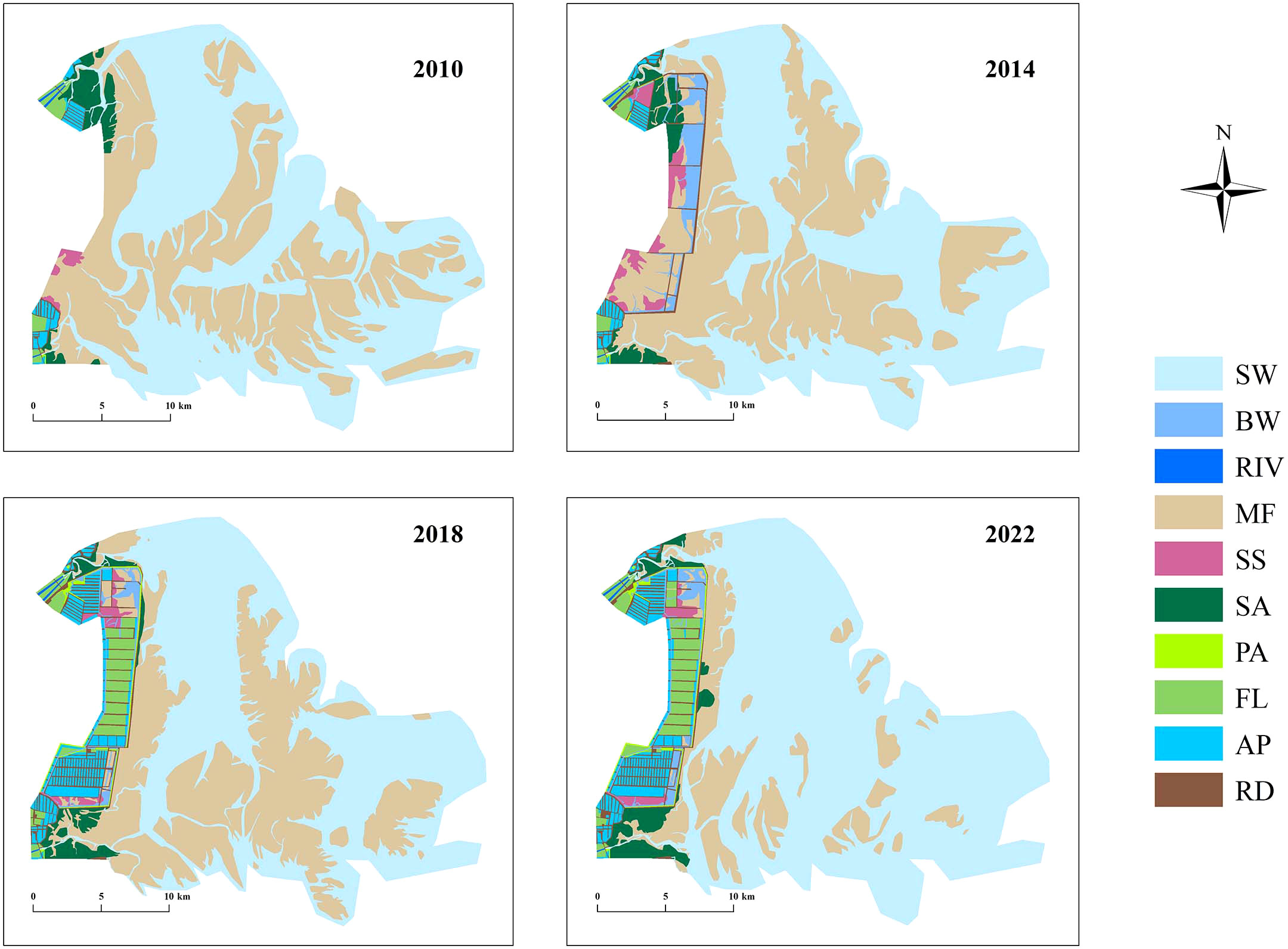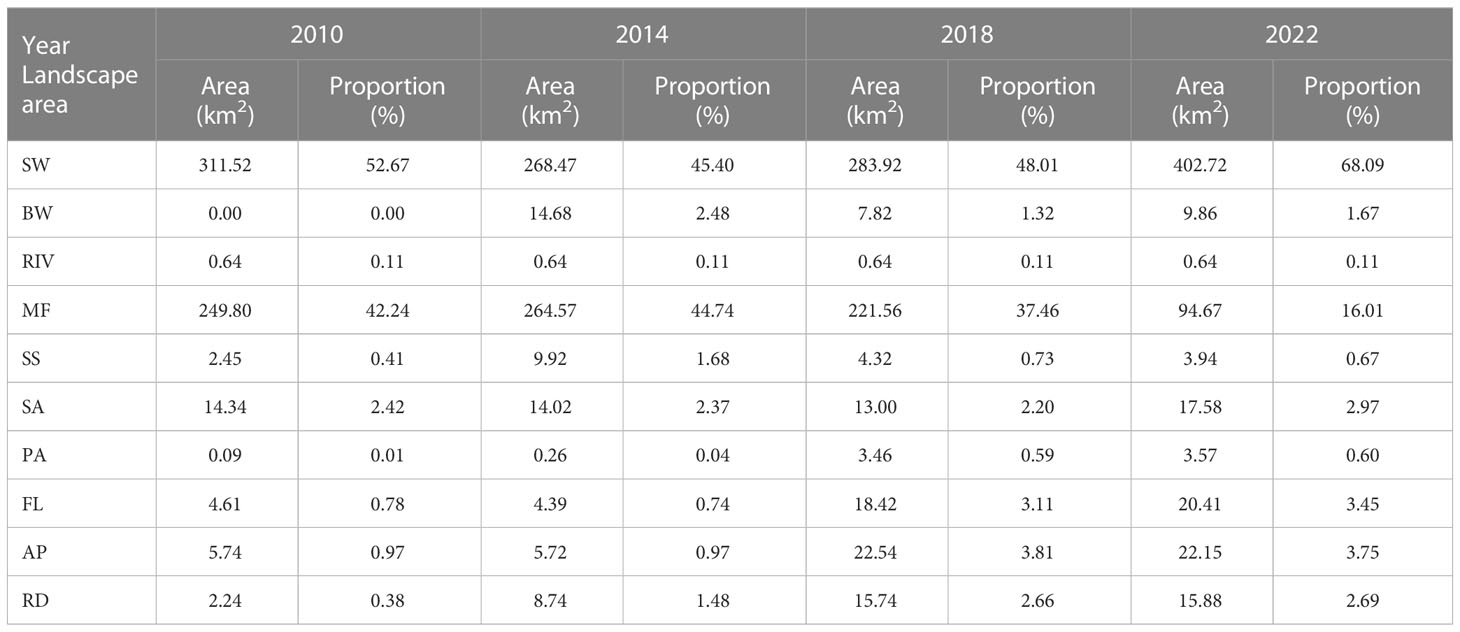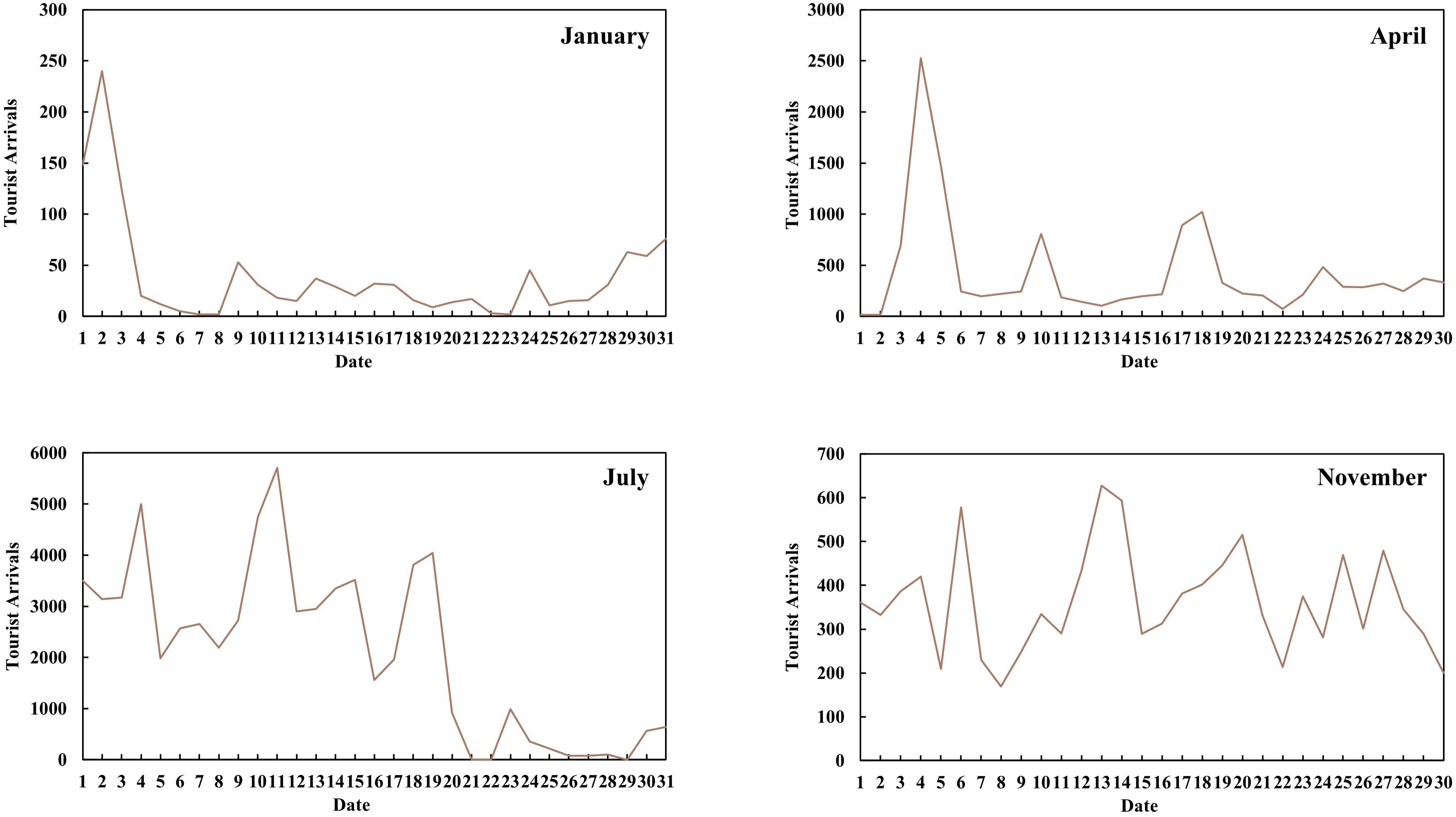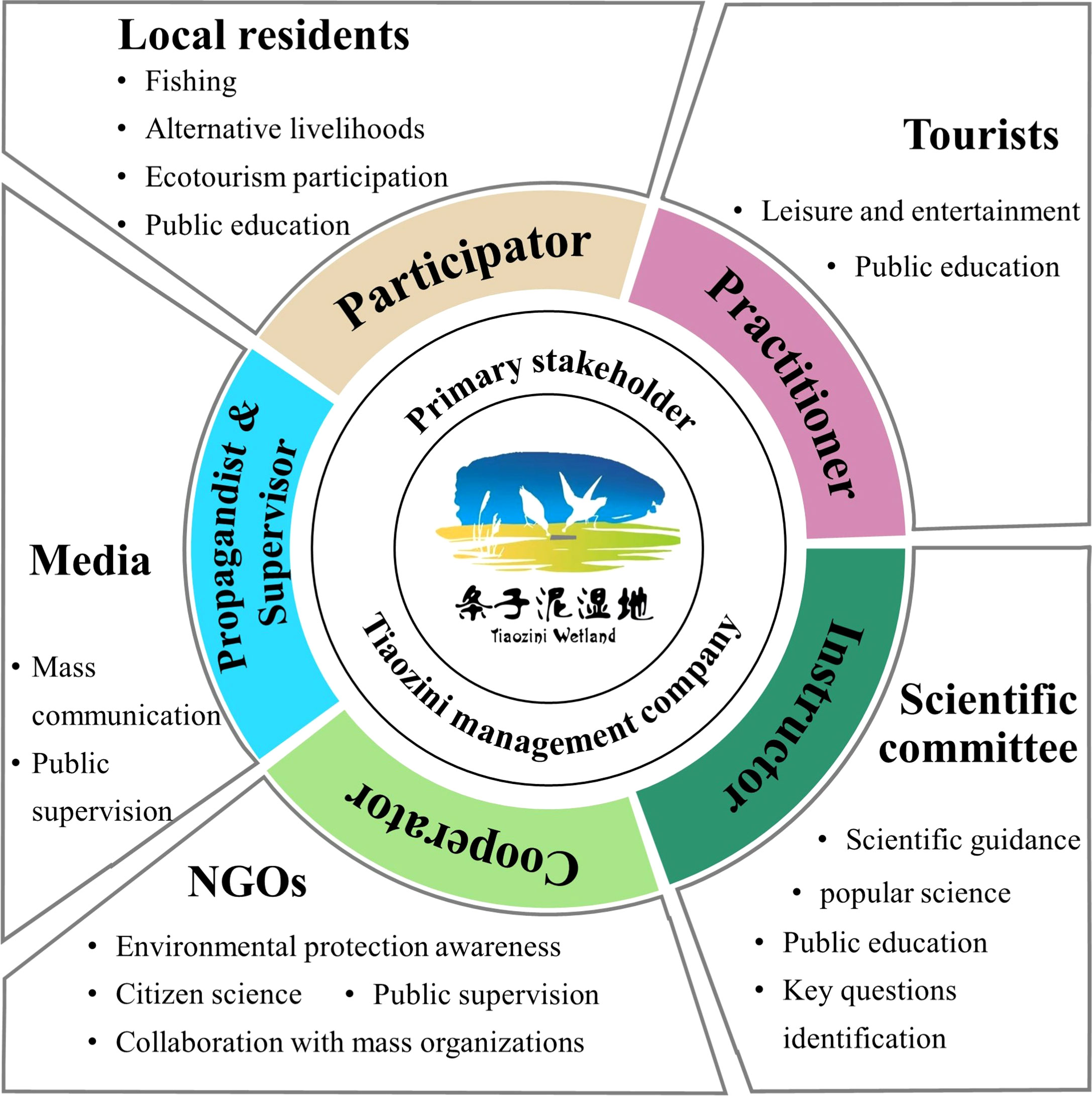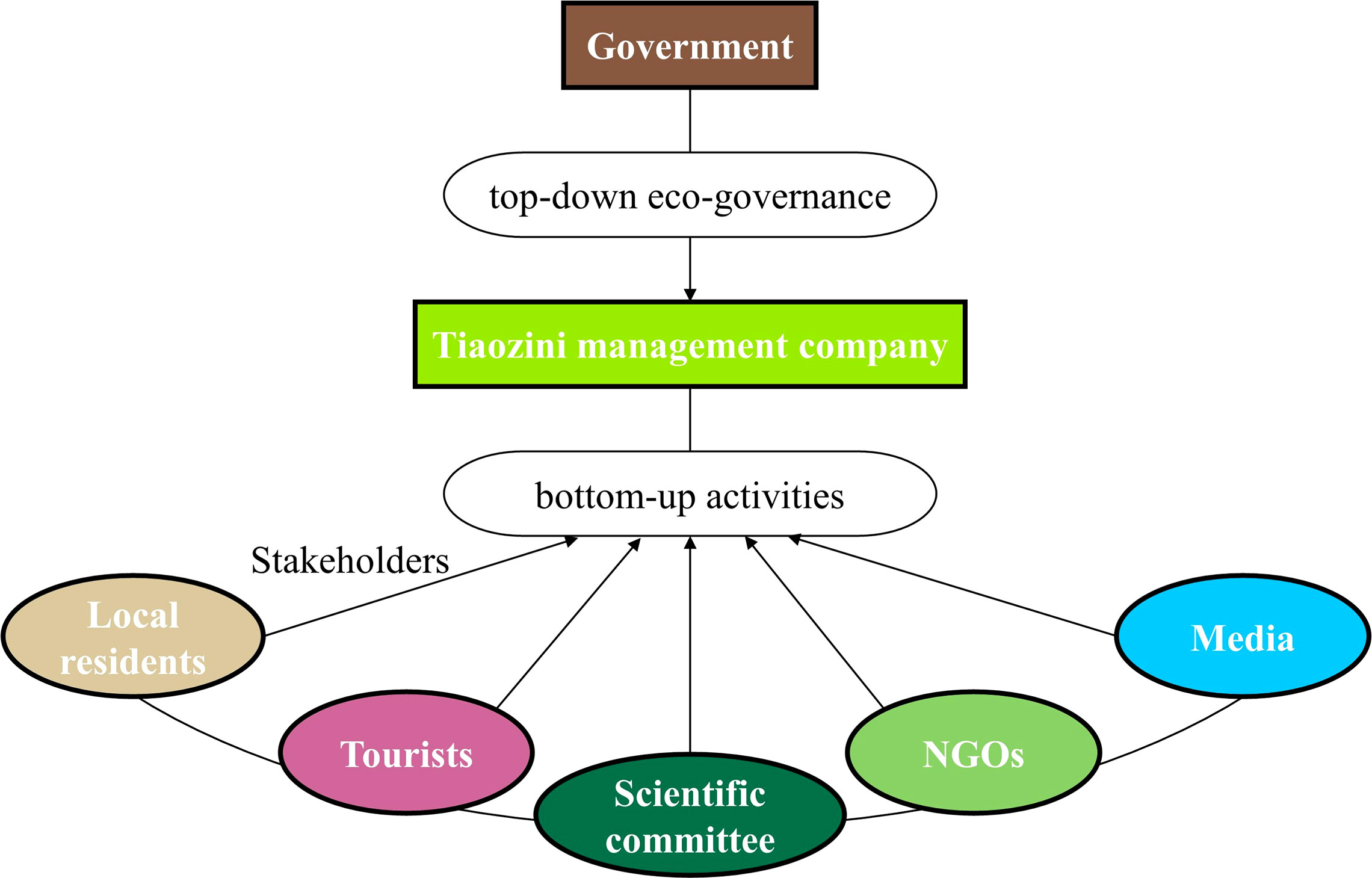- 1Key Laboratory of Coast and Island Development of the Ministry of Education, Nanjing University, Nanjing, Jiangsu, China
- 2School of Geography and Ocean Science, Nanjing University, Nanjing, Jiangsu, China
- 3Key Laboratory of Coastal Salt Marsh Ecosystems and Resources, Ministry of Natural Resources, Nanjing, Jiangsu, China
- 4Tourism Management Department, Dongtai Coastal Wetland Tourism Resort Economic Zone Management Committee, Dongtai, Jiangsu, China
Coastal wetlands provide extensive ecological services for life on Earth but are facing rapid global disappearance influenced by human activities and climate change. From 1984 to 2018, approximately 28% of the natural coastal wetlands in China were lost due to seawater intrusion, reduced sediment acquisition, urbanization, and reclamation. Tiaozini wetland used to be reclaimed during 2010-2019, and quickly shifted for conservation with less than 3 years. We analyzed 3 years of top-down eco-governance and bottom-up activities in Tiaozini, one of the typical wetlands with wise use instead of reclamation. Collaboration of stakeholders, such as the management company, local residents, tourists, scientific committees, NGOs, and media, facilitated the wise use of Tiaozini wetland as a successvie way towards eco-governance, including public participation and environmental education. Adaptive management, ecosystem-based management, and natural-based solutions play very important roles in eco-governance from both bottom-up and top-down approaches. Results showed that 3-year eco-governance induced great achievements in both biodiversity conservation and ecotourism development, which outweighs the 10-year reclamation for coastal wetlands exploitation.
1 Introduction
Coastal wetlands are distributed across all continents, except Antarctica, in low-energy tidal environments (Campbell et al., 2022) and provide immense ecosystem services for humanity. However, the long-term and continuing losses of natural wetlands have been confirmed by previous studies (Davidson, 2014; Davidson and Finlayson, 2018; Wang et al., 2020, Wang et al., 2021a; Murray et al., 2022), with drivers of drainage (Zuo et al., 2013; Watson et al., 2017), eutrophication (Deegan et al., 2012), sediment availability (Kirwan et al., 2011), sea level rise (Kirwan and Megonigal, 2013; Spencer et al., 2016) and anthropogenic pressure (Murray et al., 2022) being the main responsible factors. China’s total coastal wetlands decreased by approximately 28% from 1984 to 2018, comprising tidal flats (non-vegetated), salt marshes, and mangrove forests (Wang et al., 2021a), and the policy on Reclamation of More Lands from the Sea in China caused 7% of natural coastal wetlands loss from the 1970s to 2007 (Zuo et al., 2013). Nevertheless, the Blue Bay Remediation Action, which was issued in May 2016, shifted the coastal development policy to restoration approaches at the national level. As a result, the exploitation of coastal wetlands has been halted since then, with a new focus on rehabilitation and conservation.
The Ramsar Convention on Wetlands was signed by national governments in Ramsar, Iran, in 1971 as a global measure to stem the declining state of the world’s wetlands and the implications of this for resident and migratory wetland species (Gell et al., 2016). The Ramsar Convention already put forward the fundamental baseline of the wise use and sustainable development of wetlands based on ecosystem-based approaches (Finlayson et al., 2011). What kind of wetland use is wise use? Tiaozini wetland used to be an experimental zone of Yancheng Biosphere Reserve, which is also a Ramsar Site and one of the wintering grounds of Red-crowned cranes in China. The Tiaozini wetland is one of the typical wetlands undergoing sharp conversion from exploitation to conservation, receiving real benefits in many prospects, such as being approved at the 43rd World Heritage Conference as the core area of China’s Yellow Sea Migratory Birds Habitat (Phase I) on July 5, 2019. As the first intertidal wetland heritage site in China, the Tiaozini Wetland plays one of the key roles in presenting the current restoration and protection policy, which reinforces its biodiversity conservation in contrast to the former reclamation. With comprehensive eco-governance and the development pathway of ecotourism, it provides us with a typical example of wise and sustainable use of wetlands during the shift from wetland reclamation to conservation.
Till December 2022, there were 1,154 World Heritage sites globally, with 56 World Heritage sites in China, including 38 cultural heritages, 14 natural heritages, and 4 natural and cultural heritages (https://whc.unesco.org/en/list/). Thus, since 2019, Tiaozini has faced a sharp transition from reclamation to ecological conservation as a World Heritage site. With rapid economic development, population growth, and land demand in this century, this wetland has long been considered a potential area for reclamation. Fortunately, the Tiaozini Wetland, with its outstanding universal value for biodiversity conservation, survived the reclamation stage and was transformed into a protected area (Ye and Sun, 2021; Hu et al., 2022).
Based on the published literature, field interviews, and remote sensing technique, we analyzed the land use changes that happened due to top-down governance (those established by the government, including policies both on reclamation and eco-tourism in general) and bottom-up activities (those established by Tiaozini Scenic Spot Management Company, market-oriented, mainly about the planning and implementation of specific objects) in the Tiaozini Wetland since 2010. Ecotourism benefits were analyzed with yearly data in 2021. We aim to report the successful restoration and development path within three years of ecotourism after 10 years of reclamation, a shift that can be copied and recommended for sustainable development in other protected wetlands.
2 Study area and data analysis
2.1 Study area
The Tiaozini Wetland is located on the coast of Yancheng City, Jiangsu Province (Wang et al., 2022). It is located in the subtropical monsoon zone, with an average annual temperature of 14 ~15°C and precipitation of 1,060 mm (Zhan et al., 2021). The wetland covers contiguous non-vegetated mudflats and salt marshes covered with Suaeda salsa, Spartina alterniflora, Phragmites australis, etc. The study area includes the vast mudflats, salt marshes, and the Tiaozini reclamation area (Figure 1), with a total area of 591.41 km2. The Tiaozini reclamation area starts from the Liangduo River in the north and ends at the Fangtang River in the south.
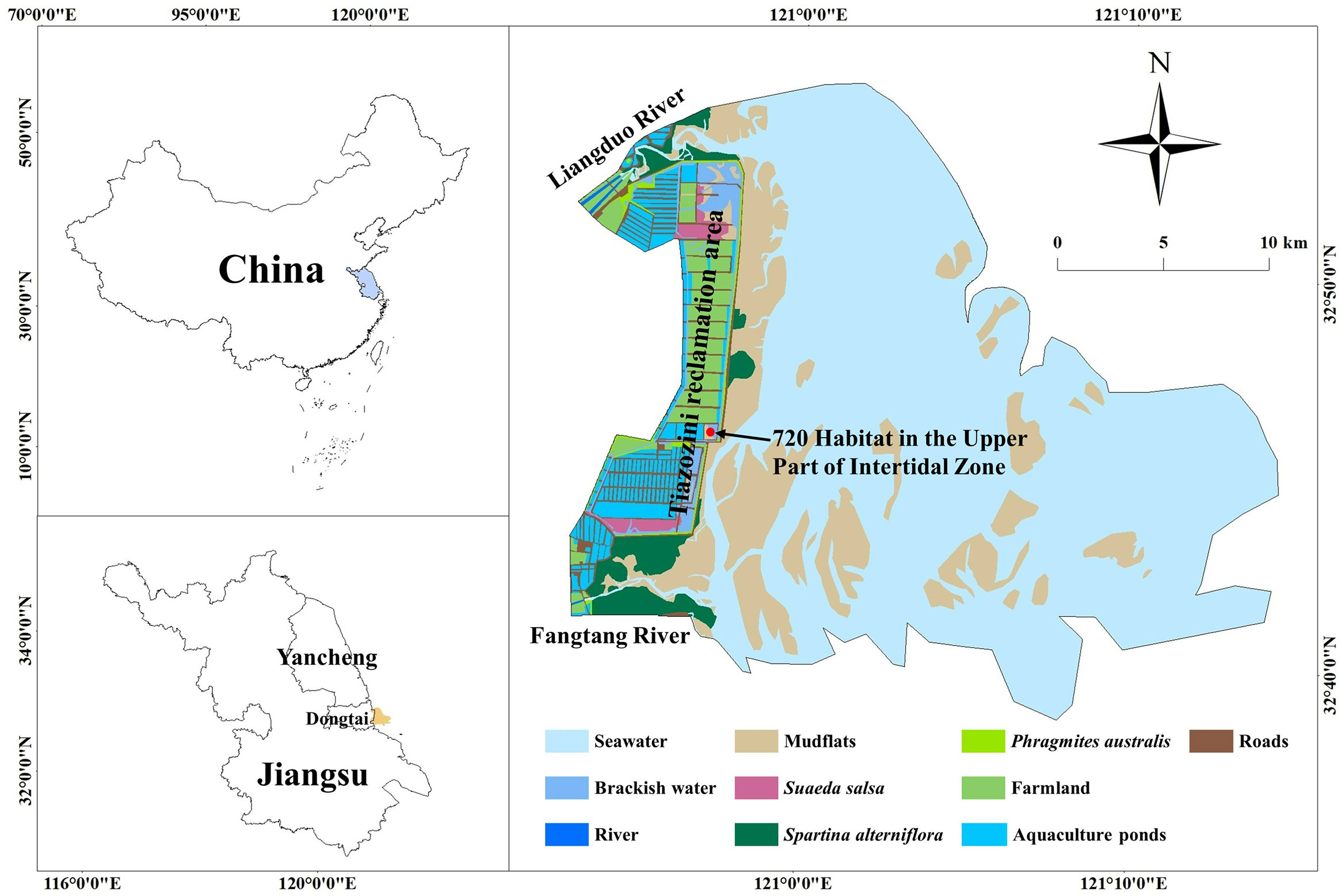
Figure 1 Map of the location and land use types of the study area, showing the 720 Habitat in the Upper Part of the Intertidal Zone (720 HUPIZ, red dot). 720 means 720 mu (0.48 km2, 1 km2 = 1 500 mu, mu is the area unit used in China).
Both the Yangtze River and the Yellow River (1128-1855) used to join the Yellow China Sea. Huge amounts of sediments fed into the Yellow Sea, contributing extensive silty and muddy tidal flats along the Yancheng coast and huge radial sand ridges filed to the South Yellow Sea. The wetland lies just behind the core of radial sand ridges with active sediment exchange and noticeable siltation. Tiaozini once produced an extensive land for reclamation that, due to sand acquisition, benefited annually from a 100 m width increase of the intertidal area (Ding et al., 2011; Figure 2). Now, due to its unique geographical location and food supply with large amounts of macrobenthos, the Tiaozini Wetland has become an important stopover, wintering, and breeding ground for millions of migrating waterbirds on the East Asian–Australasian Flyway (EAAF; Chen et al., 2015; Wen et al., 2020; Wang et al., 2021b). It has attracted some globally critically endangered species, such as the Calidris pygmaea, which uses the area for more than 2 to 3 months as a moulting ground (Peng et al., 2017; Cao et al., 2019; Gao et al., 2021; Hu et al., 2022).
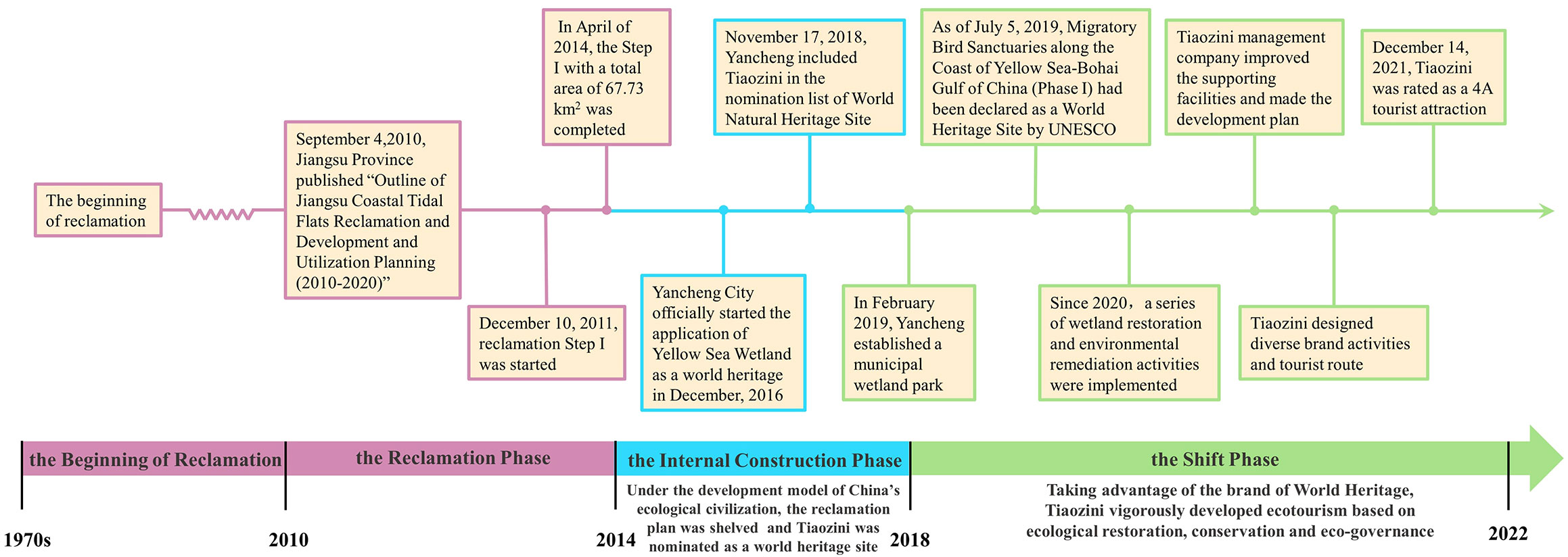
Figure 2 The milestones, processes, and political context of the Tiaozini development, including four main phases: the Beginning of Reclamation (1970s-2010), the Reclamation Phase (2010-2014), the Internal Construction Phase (2014-2018), and the Shift Phase (2018-2022).
2.2 Data source and data processing
We collected four satellite images of the Tiaozini Wetland, covering the periods of 2010, 2014, 2018, and 2022 (data source: EarthExplorer, https://earthexplorer.usgs.gov/). All satellite images were selected to coincide with the growing season of wetland vegetation (Suaeda salsa, Phragmites australis, and Spartina alterniflora) from May to October, at low tide and with less haze, representing the best available data for the purpose of this study. However, most of the images from May to October 2018 do not match the requirements (both low tide and low haze). We selected the satellite image acquired on 24 December 2018 with a clearer image. Data details are shown in Table 1.
Satellite images were corrected using on-site positioning as a reference. According to the distribution of 20 control points on each image, quadratic polynomials were applied to the correction equations. All images were then resampled to a resolution of 30 m×30 m with a root mean square error of <1 pixel. In-situ verification was conducted in the study area with 95% accuracy. Based on the interpretation of these four images, landscape-type data were obtained by supervised classification in ENVI 5.3 software. Overlay analysis was performed in ArcGIS 10.8 software.
In order to learn about the development history and status of the Tiaozini Wetland, we performed a systematic review of the literature through CNKI (China National Knowledge Infrastructure, a Chinese journal full-text database), Web of Science, Elsevier ScienceDirect, SpringerLink, etc., and carried out field investigations in December 2021, March 2022, and August 2022. We also conducted oral interviews with over 20 stakeholders of the Tiaozini Wetland, including management committee officials, ecological photographers, NGO staff, tourists, and fishermen. The tourism data were obtained from the Tiaozini Scenic Spot Management Company and analyzed by Excel.
3 Results
3.1 Background: land use analysis
In general, the Tiaozini reclamation area was mainly used as farmland and aquaculture ponds according to its former planning. The morphology of the intertidal zone changes annually with the strong influence of storm surges. However, the native vegetation is distributed from the land to the sea with a gradient effect. For instance, Suaeda salsa grows mostly in the upper part of the intertidal zone and only distributes in the northern and southern parts of the reclamation area after artificial transformation. Phragmites australis distributes along the man-made seawall road inside the reclamation area with fresh water supply, while Spartina alterniflora forms a single dominant vegetation in the middle and lower parts of the intertidal zone, outside of the road adajacent to the sea directly. We divided the study area into 10 types based on land use, including seawater (SW), brackish water (BW), river (RIV), mudflats (MF), Suaeda salsa (SS), Spartina alterniflora (SA), Phragmites australis (PA), farmland (FL), aquaculture ponds (AP), and roads (RD).
Figure 3 shows the land use changes in temporal and spatial scales during 2010-2022. The landscape of Tiaozini has changed significantly from 2010 to 2022 on the temporal scale (Table 2). Mudflats, as the dominant natural wetlands, declined from 249.80 km2 to 94.67 km2 with a 62.11% loss from 2010 to 2022. The land cover of brackish water, Suaeda salsa, Phragmites australis, and roads increased significantly during 2010-2014, which is called the reclamation phase (Figure 2). In 2014, a dike or seawall with a length of 27.78 km could be clearly identified. The terrestrial part inside of the seawall was converted to artificial wetlands for aquaculture and agriculture. During the period spanning from 2014 to 2018, we referred to it as the internal construction phase (Figure 2). This phase witnessed various companies renting individual aquaculture ponds. The area of farmland increased by 14.03 km2, aquaculture ponds increased by 16.82 km2, and roads increased by 7.00 km2 in 2018 compared to 2014. Suaeda salsa covered an area of 4.32 km2, with a reduction of 56.45% since 2014. Phragmites australis habitat increased to 3.46 km2 due to the construction of ditches within the reclaimed area. From 2018 to 2022, adaptive management for ecotourism and biodiversity conservation resulted in less landscape change in the reclamation area and almost no increase in artificial landscapes. We named this period the shift phase (Figure 2). Spartina alterniflora expanded to 17.58 km2 outside the reclamation area in 2022. Besides, Suaeda salsa decreased by 8.80% and Phragmites australis increased by 3.20% compared to 2018. The most significant shift in the area was the purchase by the Coastal Development Corporation of use rights related to 720 habitats in the upper part of the intertidal zone (Figure 1). Dongtai Coastal Wetland Tourism Resort Economic Zone Management Committee, which organizes the scenic spot for ecotourism and conservation, purchased the use rights of the 720 mu artificial wetland for shorebird conservation from the Coastal Development Corporation in 2020. The event made an outstanding mark between use rights and ownership of biodiversity conservation among Tiaozini wetland-owned stakeholders.
Significant changes could be observed in the last 12 years (Figure 4). In the reclamation phase of 2010-2014, 4.70%, 2.49%, 1.62%, 0.02%, and 1.51% of mudflats were converted to brackish water, Suaeda salsa, Spartina alterniflora, aquaculture ponds, and roads, respectively. Other landscape types changed less. During the internal construction phase from 2014 to 2018, the area of brackish water and mudflats decreased due to internal construction in the Tiaozini reclamation area. The area of Suaeda salsa marsh changed with 6.89%, 1.41%, 10.94%, 24.84%, 33.50%, and 12.80% of the area being transferred to brackish water, mudflats, Phragmites australis, farmland, aquaculture ponds, and roads, respectively. The area of Spartina alterniflora marsh was less changed. However, the Spartina alterniflora community had been moved out of the reclamation area, which had spread widely on the mudflats adajacent to the sea dike. Moreover, farmland, aquaculture ponds, and roads gained more land from brackish water and mudflats in the reclamation area. The great shift phase of 2018-2022 experienced a sharp conversion for wetlands use and management. Therefore, the landscape tended to be much more stable in the reclamation area. The majority of mudflats turned to seawater, which was impacted by the rising tides. During the 2018-2022 major shift phase, there was a sharp change in wetland use and management. Therefore, the landscape in the reclamation area tended to be much more stable. Most of the tidal flats were transformed into seawater, which was affected by the rising tides. Spartina alterniflora spread to 5.81 km2 along the intertidal zone. In particular, the 720 HUPIZ was first designated as permanent habitat for shorebirds, especially migratory birds in the East Asian–Australasian Flyway, with artificial water level mitigation and food supply.
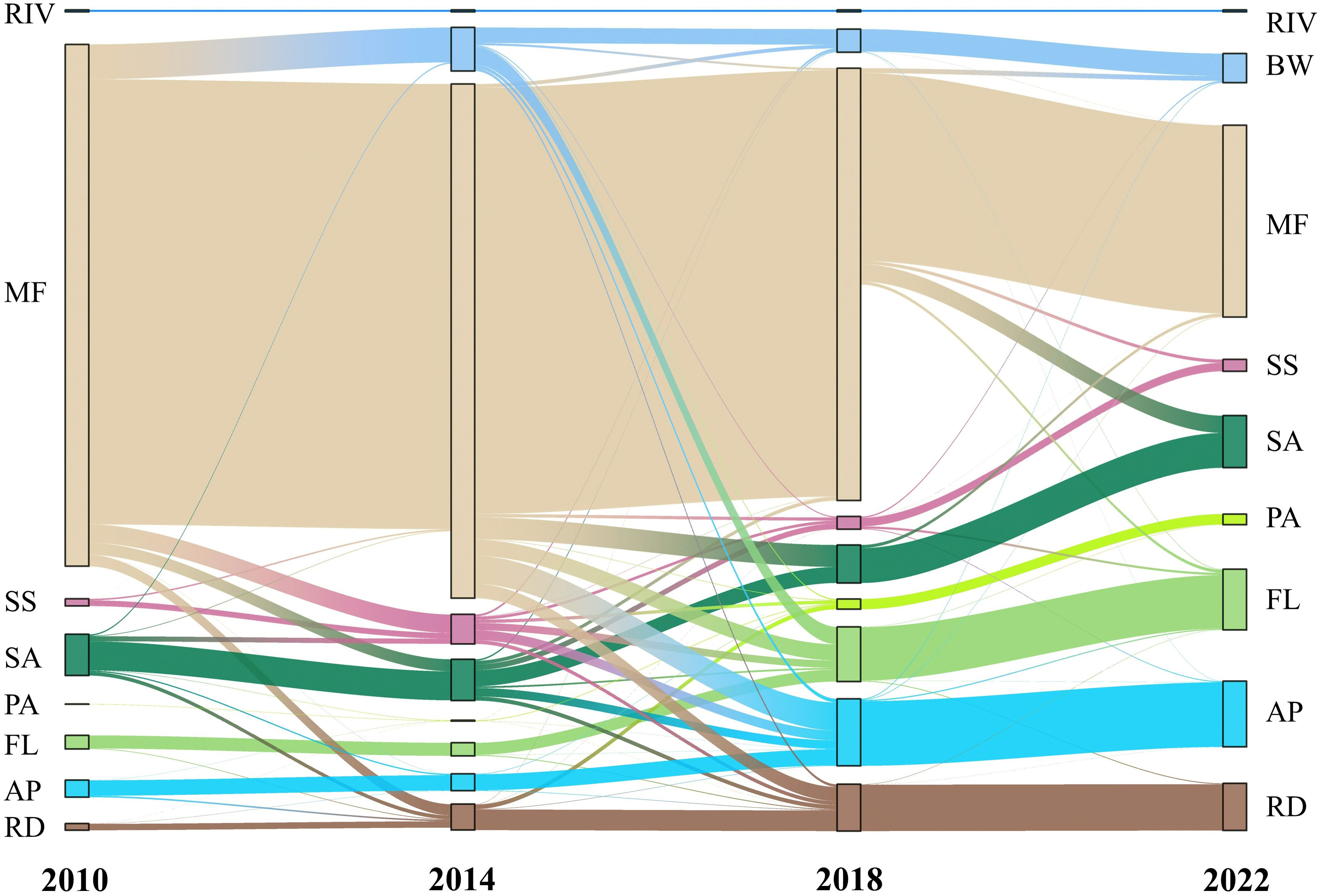
Figure 4 Land use transition in Tiaozini from 2010 to 2022, drawn according to Table 2. Bolder lines indicate a bigger transfer.
It was observed that mudflats transferred to other land use types in general. After 2014, when phase I of reclamation was completed, mudflats outside the seawall were in a state of natural change, almost free from artificial interference. Therefore, the year 2014 was the time when the sea dyke was finished. More intertidal mudflats were converted to Spartina alterniflora marsh with natural expansion, while other parts inside the reclamation area were shifted to farmlands, aquaculture ponds, and roads due to intensive infrastructure construction by the Coastal Development Corporation. For salt marshes, which include Suaeda salsa, Spartina alterniflora, and Phragmites australis, the total area increased by 20.74% in 2022 compared to 2018. When the Tiaozini Wetland was nominated as a World Heritage site in 2018, the large, contiguous mudflats and high carbon-storage salt marshes of the Tiaozini Wetland finally survived potential reclamation. Hence, its unique charm has the opportunity to attract more tourists and also provide rich ecosystem services for local organisms and biodiversity.
3.2 Top-down eco-governance: rapid transformation and adaptive management
The reclamation of Tiaozini began in the 1970s with the national policy of More Land from the Sea (Ding et al., 2011; Wang et al., 2012; Li et al., 2016). At the beginning of this century, land resources in Jiangsu Province became scarce. Reclamation of coastal wetlands turned to land reserve resources for ports, industrial parks, or aquaculture ponds with urbanization and industrial development. In June 2009, Jiangsu Coastal Area Development Plan was approved by the State Council of the People’s Republic of China. Therefore, land acquisition from the sea had accelerated since the Provincial Bureau issued the Outline of Jiangsu Coastal Tidal Flats Reclamation and Development and Utilization Planning (2010-2020) in 2010 (Zhang et al., 2013; Li et al., 2015; Xu et al., 2017; He et al., 2021). The outline clearly stated three stages for Jiangsu coastal tidal flats reclamation, with the objective of acquiring 1800 km2 of land in the radial sand ridges. The Tiaozini Wetland was primarily listed in the first development stage for 230.67 km2 of land reclamation with three steps. As Figure 3 shows, the project finished Step I of 67.73 km2 of lands from the intertidal zone in 2014, mainly for the usage of aquaculture and agriculture, covering the interconnecting beach between Liangduo Estuary and the north side of Fangtang River sluice (Wang et al., 2012; Li et al., 2016; Sha and Wang, 2021; Yu et al., 2022).
During the internal construction phase, the national coastal development strategy shifted from exploitation to conservation and restoration. The 18th National Congress of the Communist Party of China incorporated ecological civilization construction into the five-sphere Integrated Plan for building socialism with Chinese characteristics, setting the goal of building a beautiful China. The congress also made it clear that China should “enhance its capacity to utilize marine resources, develop marine economy, protect the marine ecological environment, resolutely safeguard China’s maritime rights and interests, and build itself into a maritime power”, marking the construction of marine ecological civilization being elevated to the height of national strategy (Xu et al., 2016; Ma et al., 2021; Huo et al., 2022; Lei et al., 2022; Li et al., 2022; Zhang et al., 2022). Since then, China had made a series of important plans for ecological civilization construction at the national level, such as the Implementation Plan for Marine Ecological Civilization Construction, Suggestions for Establishing the Marine Ecological Red Line System, the Wetland Protection and Restoration Scheme, and the Blue Bay Initiative. As a result, the development model of the marine economy was shifted as the earlier wetland reclamation planning was delayed or canceled. China’s coastal restoration has entered a rapid development stage in recent years with the policy of ecological civilization construction. There are various projects focusing on different types of coastal ecosystems, including tidal flats, mangroves, and sandy beaches in the coastal zone. More than 125 restoration projects are being carried out along the Chinese coast. (Liu et al., 2016; Chen et al., 2019; Li et al., 2022). Thus, Tiaozini’s Step II reclamation plan was not approved for further construction, nor was Step III.
In December 2016, Yancheng City proposed the application procedure for the Yellow Sea Wetland as a World Heritage site. Tiaozini was included in the nomination list for World Natural Heritage Site through the joint efforts of the local government, NGOs, scientific committee, and environmentalists. From then on, the original reclamation plan was delayed. The local departments quickly shifted the early former policy to restoration and implemented adaptive management to tidal wetlands conservation. The municipal government announced the establishment of Tiaozini Municipal Wetland Park in February 2019. As of 5 July 2019, Migratory Bird Sanctuaries along the Coast of Yellow Sea-Bohai Gulf of China (Phase I) was declared as a World Heritage site by the United Nations Educational, Scientific and Cultural Organization (UNESCO), and was also listed as China’s first coastal wetland natural heritage site. As an important part of the Natural Heritage Site, the Tiaozini Wetland completely abandoned the previous reclamation plan and implemented a series of bottom-up activities to realize top-down eco-governance concepts instead, such as converting 11.33 km2 of fish ponds into wetlands, creating the 720 HUPIZ, and establishing breeding grounds for Larus saundersi.
3.3 Bottom-up activities: comprehensive conservation and management
Conservation measures and adaptive management strategies were decided, such as the nature-based planning of landscape and infrastructure, exhibitions focused on biodiversity conservation, environmental education, and media dissemination. Ecotourism in the Tiaozini Wetland developed at the very beginning of the shift phase in 2019, and in less than four years multiple ecotourism products were developed to attract tourists. Besides, a comprehensive recreation center focusing on residents, visitors, and businesses, a sanatorium and space for conferences are being built so as to provide up-market service for whoever needs it, with the aim to promote ecotourism in Tiaozini.
3.3.1 Supervision and management of the ecological environment
The Tiaozini management company converted 0.48 km2 of fishponds to wetlands and used it as the 720 HUPIZ to provide a habitat for waterbirds by restoring micro-topography, strictly controlling weed height, and maintaining water quality and water level. To the north of the wetland restoration area, 1.87 km2 of breeding grounds for Larus saundersi were designated with full-time guards patrolling 24 hours a day during the breeding season. Moreover, the company applied a timely intelligent management system for surveillance, with 317 network cameras for bird watching, science popularization, research and education.
3.3.2 Nature-based planning of landscape and infrastructure
Tiaozini successively carried out the project of paving, widening, landscaping, and installing guardrails on the 45 km-long coastal road, with the opening of a visitor center, four break areas, and several parking lots. Tourist attractions such as “Watching the Sea and Listening to the Tide”, “Habitat at High Tide Level”, and “Breeding ground of Larus saundersi” were launched along the seawall. In all, 28 internet-famous sites such as “Two Halves of Water”, “One-line Tide”, “Wetland Chinese Red”, “Mirror of the Sky”, and “Tidal Forest” were designed based on the natural landscapes. And the company set up 26 high-power telescopes to enhance the visiting experience. At the same time, in Jianggang, the town near Tiaozini, infrastructure, such as Magnotel, James Joyce Coffetel, Yucun bar, and Tiaozini seafood restaurant, was built to provide tourists with accommodation and catering.
3.3.3 Creation of the multi-platform propaganda position
As the saying goes, “Deeply buried gold cannot shine.” Although Tiaozini has made some achievements in ecological restoration, conservation, and infrastructure improvement, laying a good foundation for ecotourism, there is still a need to attract more visitors. In addition to promoting the fascinating wetland scenery and ecological restoration achievements through TV programs, newspapers, and magazines, the management company also relies on new media to carry out online live broadcasting and offline market promotion meetings to promote Tiaozini on multiple platforms.
3.3.4 Development of diverse ecotourism products based on natural heritage
Taking advantage of its World Heritage site status, Tiaozini developed several kinds of nature-based products that both met visitors’ expectations and enhanced their experience. More than 40 cultural and creative products such as journals, bookmarks, key rings, jigsaw puzzles, and umbrellas, with coastal wetland elements, such as Spoon-billed Sandpiper, Saunders’ Gull, mudskipper, and tide, have been developed. It has become an internet-famous site for WeChat influencers to take selfies with tourist routes, e.g., “Be Close to the World Heritage”, “Bird Paradise · Ecological Dongtai”, and “Coastal Wetland · World Heritage Tour”. Tiaozini organizes thematic activities such as “Beach Fun”, “Bird Week”, bird scenery photography contests, wetland triathlons, etc., guiding tourists to go into the wetland, enjoy the wetland and participate in protection. Folk performance comes from local fishermen who dress in traditional costumes to help visitors learn about the local fishing culture, such as “Fishing Trumpet”, “Picking Shellfish”, “Weaving and Mending Nets”, and “Casting nets”. They earn their living by performing, which also preserves local culture as a kind of alternative livelihood.
3.3.5 Promoting the construction of a recreation center
Tiaozini Wetland has two outstanding advantages of “coastal wetland” and “migratory birds paradise”, which is a perfect place for recreation and leisure, science popularization, and as a sanatorium. Focusing on the target audience in the Yangtze River Delta, Tiaozini plans to build a healthy and livable coastal town in Jianggang, which would promote the ecotourism industry and help people live a high-quality green life.
3.4 An example from ecotourism design: response from annual tourists
3.4.1 Annual tourist arrivals
The Tiaozini Wetland received 266,000 tourists in 2021 (data source: Tiaozini Scenic Spot Management Company, 2021, unpublished), with the exception of early August through mid-September due to closure for facility maintenance. Figure 5 shows the 2021 daily tourist arrival data. It can be seen that visitation displayed a perfect peak-forest structure corresponding to national holidays, such as Tomb Sweeping Day, International Labor Day, the Dragon Boat Festival, summer vacation, the Mid-Autumn Festival, and the National Day of October 1st. The regular change of visiting time in Tiaozini Wetland agreed with most of the famous tourist sites in China (Sun and Zhou, 2011; Zhang and Sun, 2014; Rong et al., 2020; Ma et al., 2021), indicating that Tiaozini has become, within 3 years, a healthy scenic spot.
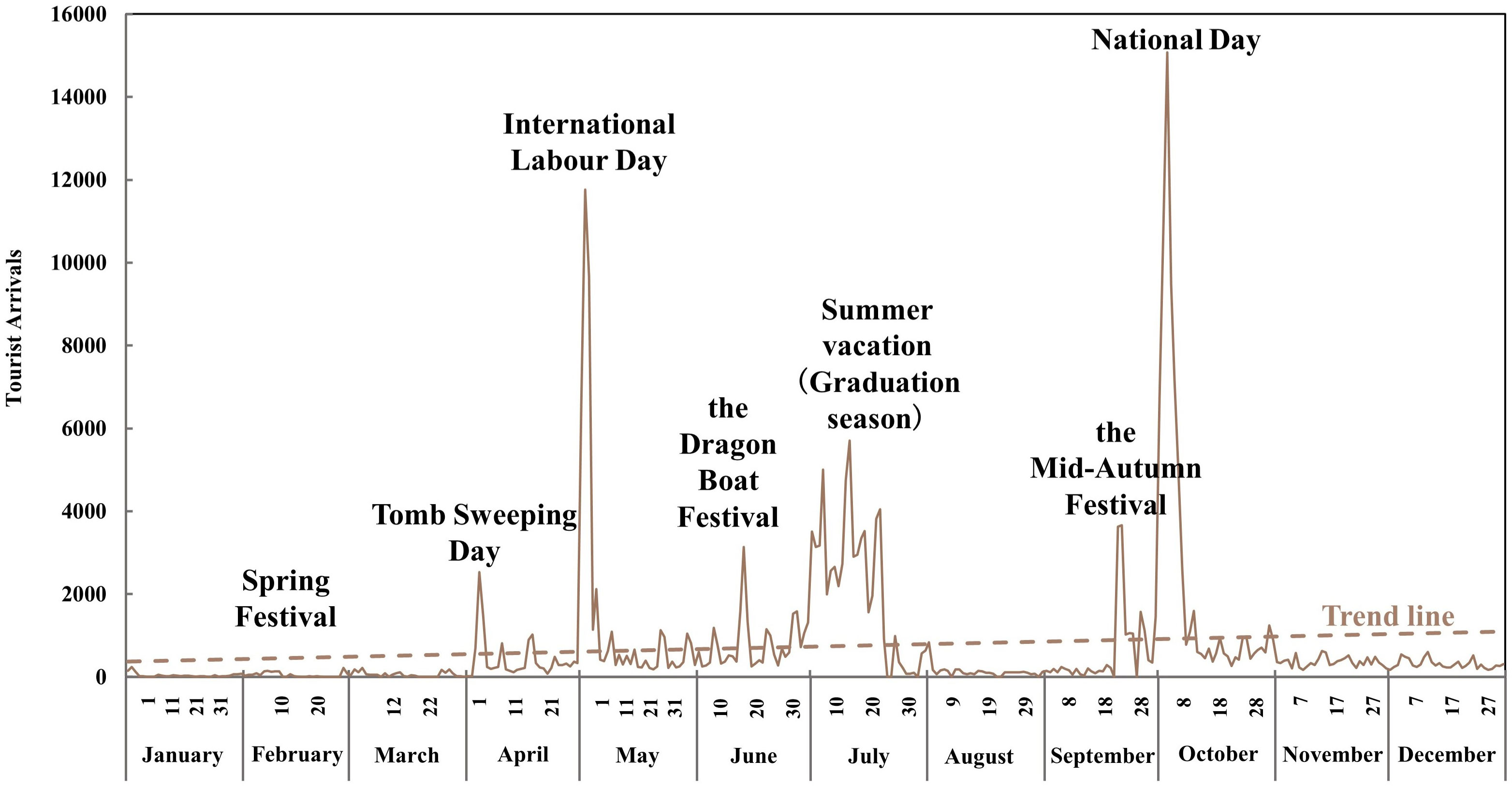
Figure 5 The annual tourist arrivals in 2021. Main peaks are noted in the figure, including Spring Festival (February 12th), Tomb Sweeping Day (April 4th), International Labor Day (May 1st), the Dragon Boat Festival (June 14th), summer vacation or graduation season (July to August), the Mid-Autumn Festival (September 21st), and National Day (October 1st).
The Tiaozini Wetland is located on the middle east coast of China with approximately 200 km direct distance to the northeast of the Yangtze River estuary. This area shows distinct four-season changes of spring, summer, fall, and winter with the northern subtropical monsoon climate. Therefore, in the cold season, from January to March, fewer tourists come to Tianzini, except naturalists and bird watchers. More tourists come here with daily rising temperatures. When the weather warms up, the number of tourists begins to increase and fluctuate. The annual peak season is from the beginning of May to the end of October, corresponding to the holiday and warm seasons. As the temperature gradually drops in early November, tourism shifts from the peak season to the off-season. In addition, the zigzag peaks could also be clearly described as weekly peaks due to weekend visitors. Apart from the climate, the data show that tourism in Tiaozini is connected to people’s working schedules and holiday systems, with most visitors preferring to travel on weekends and holidays.
It should be mentioned that COVID-19 also posed some negative impacts on tourist arrivals. However, tourism in Tiaozini still showed an overall rising trend in 2021, which to some extent reflected the great achievements based on advisable eco-governance, development strategies, and remarkable eco-tourism design.
3.4.2 Monthly tourist arrivals
We took a deep dive into the monthly variation of Tiaozini ecotourism. The number of tourists in January, April, July, and November were selected based on the peak-forest structure and off/peak seasons, as seen in Figure 5. As shown in Figure 6, the number of visitors in January was generally low, peaking in the first few days of the month with fewer than 250 visitors over the New Year’s holiday. Tomb Sweeping Day (Qingming Festival, in Chinese) is a traditional holiday dedicated to the memory of deceased relatives, and most people choose to make a short trip after the memorial ceremonies. Therefore, Tiaozini received 2,527 tourists on April 4th as the first peak of the year. The average tourist number was approximately 400 per day in April. Tourism peak season came in July and August corresponding to the summer vacation and graduation season. The number of tourists increased greatly and there were approximately 2,110 tourist arrivals every day. Besides, the number of tourists reached the lowest at the end of July due to the closure of the scenic spot. In November, the off-season of Tiaozini tourism began, and the overall number of tourists showed a downward trend with fluctuation at a low level, approximately 400 per day.
International Labor Day in May and National Day on October 1st are called golden weeks for tourism with 7 days off work in mild and comfortable seasons in China. Both holidays revealed peaks in the tourist numbers, with average daily visitors of 6,261 and 8,121, respectively, of which the highest was over 10,000 per day Figure 7. After the holidays, the daily amount stabilized at around 500 and 700, respectively, after the golden weeks. These two holiday dates showed similar characteristics of peak forest structure. It is worth mentioning that the peak of tourist numbers occurred on May 2nd and October 3rd during the Chinese Golden Weeks. It is inferred that there was a lag effect of 2-3 days in tourist arrivals during the holidays as travelers had to spend one or two days to reach their destinations at the beginning or end of the holidays.
3.4.3 Tourist arrivals on each weekday in 2021
The number of tourists within 7 weekdays indicated when and how long they would stay in the Tiaozini Wetland. There was a significant difference between weekdays and weekends according to the number of weekly tourists. We found that the number of visitors to Tiaozini on Saturdays and Sundays was much higher than that on weekdays, accounting for nearly 50% of the tourists in 2021 (Figure 8). Tourist arrivals on Fridays accounted for 10%, whereas tourists arriving on Mondays accounted for 17%, which was higher than that of the other four weekdays.
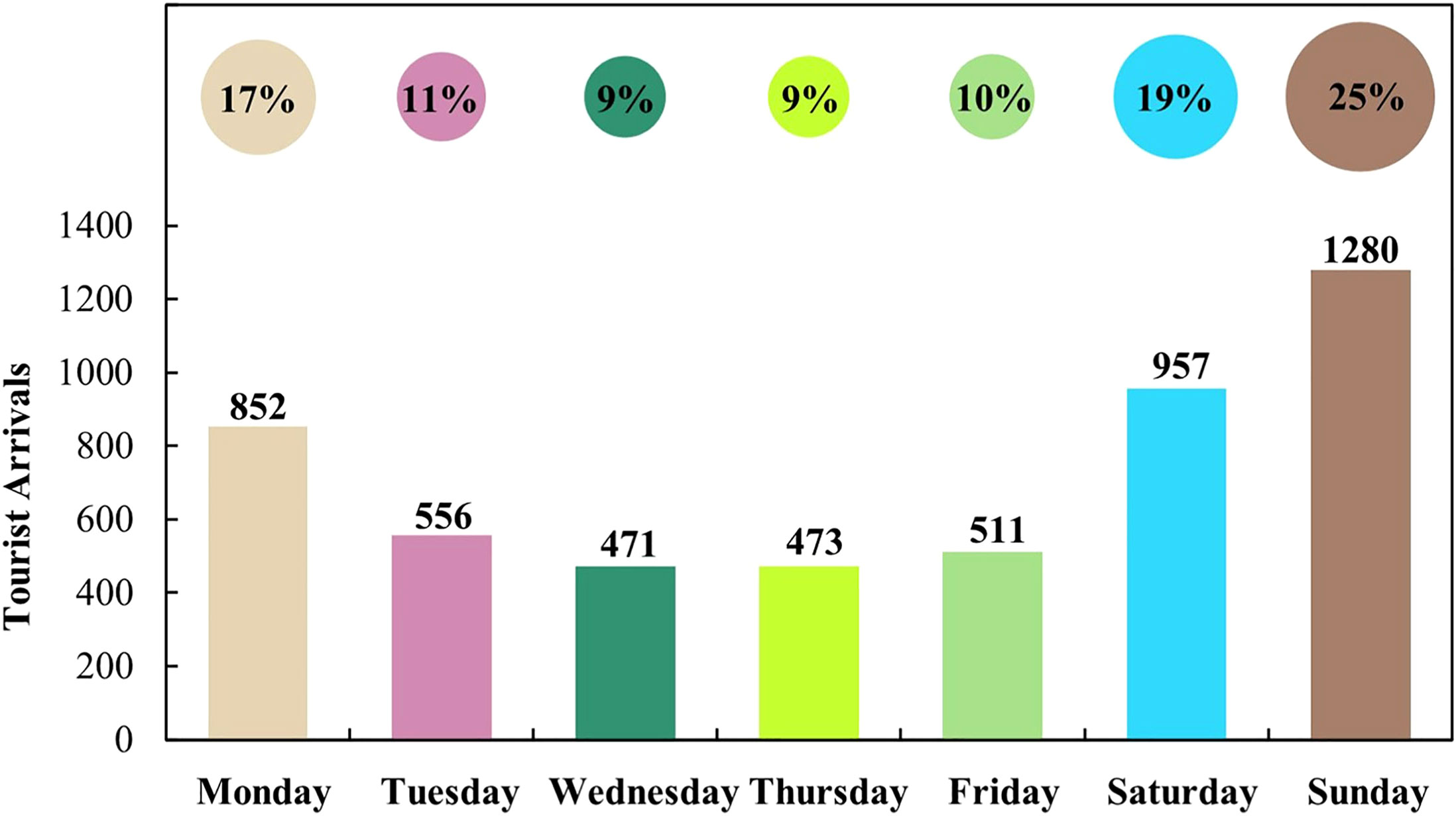
Figure 8 Tourists arrival numbers per each weekday. The bar represents the amount of tourists and the filled circle represents the proportion.
3.5 Stakeholders collaboration, public participation, and environmental education
Six stakeholders were identified: Tiaozini management company, local residents, tourists, the scientific committee, NGOs, and the media. Figure 9 illustrates the relationship between the six stakeholders. Tiaozini management company is the primary stakeholder with the use rights of Tiaozini Wetland. It also fulfills its obligations to maintain infrastructure and manage and develop ecotourism activities.
3.5.1 Local residents
The local coastal residents have the birthright to fish in the sea and use coastal wetlands for survival and livelihood. Local stakeholders are involved in a trade-off between the benefits they receive from tourism and the loss of their historical rights to wetland usage. If they perceive the costs of ecotourism to outweigh the benefits, they will withdraw their support. Therefore, it is incumbent on a tourism-responsible person to try to optimize the well-being of local residents whilst minimizing the costs of tourism development (Sharpley, 2013; Bu et al., 2021). Accordingly, it is also indispensable to provide alternative livelihoods and vocational training for the local residents to increase job opportunities.
In Tiaozini, fishermen are still allowed to engage in productive activities in the coastal area. However, the Tiaozini management company also provides more employment opportunities for local residents. Folk performances related to fishing, clam digging, and other mudflat production activities are scripted into live shows that are performed for tourists at festivals or organized tour groups. All performers come from local communities and used to be fishermen. Well-paid salaries and respect encourage them to actively participate in their new jobs and in wetland protection. Alternative livelihoods, such as folk performers, landscapers, lifeguards, drivers, and tour guides, provide local people with various employment opportunities instead of fishing or other production activities in mudflats. Local people also act as trainees, regularly receiving the knowledge of public awareness of environmental protection and biodiversity conservation offered by the Tiaozini management company. The perceived win-win benefits from ecotourism managers and local stakeholders brought positive effects in terms of economic development, wetland protection, and biodiversity conservation.
3.5.2 Scientific committee
The scientific committee plays a very important role in the wise use of the Tiaozini Wetland, top-down eco-governance, NGO collaboration, and bottom-up adaptive management related to ecotourism development and biodiversity conservation. The Tiaozini Wetland Center offers a laboratory of over 5000 m2 for professors and students from universities and other academic institutions to carry out research on coastal wetlands. Their original findings related to the Tiaozini Wetlands mostly provide enlightening and concrete visions to local officials, which helps them in eco-governance decision-making. The theoretical guidance that focuses on the identification of key issues used to serve as an important part of ecotourism management, popular science, and public education. In turn, the ecotourism and eco-governance practice in the Tiaozini Wetland has become a realistic laboratory for coastal wetlands management in China.
3.5.3 Tourists
In general, ecotourism is the business of providing vacations and related services that do not harm the environment of the visited area. Economic activities that are environmentally friendly to nature are part of the low-level demands of ecotourism. In addition, it is the responsibility of destinations to provide ecological education for tourists on natural habitats (Powell and Ham, 2008; Lee, 2021). Ecotourism in Tiaozini meets the basic requirements for both environmental protection and economic development. However, the Tiaozini management company tries to promote the nature experience for tourists by being deeply involved in mudflats activities, such as Meretrix meretrix L. digging, finding macrobenthos, and bird watching. In addition, the Tiaozini Wetland Committee also tries to educate tourists about both environmental protection and science propagation. Many ecotourism products are developed to enhance tourists’ experience of wetland culture, such as clock sites, cultural and creative products, performances in festivals, commemoration days, or anniversaries of important events.
3.5.4 NGOs
The Tiaozini Wetland Center develops good collaboration with many NGOs, such as Shenzhen Mangrove Conservation Foundation (MCF), Spoon-billed Sandpiper Conservation Alliance, Friends of Nature (FON), and so on. One of the missions of NGOs in Tiaozini is to raise public awareness about biodiversity conservation, especially of some flagship species such as Eurynorhynchus pygmeus, Platalea minor, Grus japonensis, Calidris tenuirostris, and Elaphurus davidianus. The NGOs played a very important role in establishing communication channels through various talks, meetings, workshops, and conferences, either on formal or informal occasions. They are actively involved in ecotourism development plans and provide crucial technical, financial, educational, and construction support for Tiaozini tourism. NGOs also bridged partnerships to undertake specific conservation projects, helping to organize and empower local communities and provide financial support (Romero-Brito et al., 2016; Wondirad et al., 2019).
3.5.5 Media
The media refers to television, radio, newspapers, and magazines, as well as platforms such as WeChat, Tiktok, and other social media services. The media plays an irreplaceable role in promoting tourism sites and in spreading ecotourism knowledge propagation and environmental education. The Tiaozini management company uses all the abovementioned media for both biodiversity conservation and ecotourism development. Its official account on WeChat provides daily information on the weather, tides, transportation, and available activities, providing convenience for tourists. On the other hand, both tourism activities and infrastructure construction in Tiaozini are under public supervision by the media. The Tiaozini management company has established good communication with many traditional media, such as The People’s Daily, China News, and Guangming Daily. It also launches many programs on China Central Television, Jiangsu Television, and so on. New media represented by WeChat, TikTok, Xiaohongshu, and search engines also play an increasingly important role in publicizing the ecological conservation and tourism development of Tiaozini. These media also provide ecological education and popular science to the public, which is not limited to tourists in Tiaozini, drawing their eyes to this new wetland attraction site.
4 Discussion
4.1 Wise use of the Tiaozini Wetland
National policy, such as the Five-Year Plan, dominates land use changes. The land use analysis and top-down eco-governance studied in the present research were consistent with the national policy. Before 2019, the Tiaozini Wetland was on the list for reclamation, and less attention was paid to maintaining its “ecological character” and biodiversity conservation. However, the successful approval of the Tiaozini Wetland as a World Heritage site stopped the reclamation and converted measures into conservation in July 2019. Then, ecological restoration and environmental protection were vigorously promoted by wetland managers with a top-down eco-governance policy.
To achieve sustainability and the wise use of a natural heritage site, it is essential to recognize that support and resources from multiple stakeholders are the most dominant power. The management company cooperated with scientific committees, NGOs, the media, and other stakeholders to develop a new sustainable field for the Tiaozini Wetland, facing the dilemma of sharp conversion from exploitation to conservation with bottom-up activities for better accommodating nature-based solutions (Figure 10).
As the primary stakeholder, the Tiaozini management company adopted diverse approaches to developing ecotourism, including environment monitoring, nature-based planning of landscape, infrastructure construction, multi-platform publicity, diverse cultural and creative production, and recreation center promotion.
Governments often choose ecotourism as a strategy for local economic growth (Lee, 2021), and this was the case with the Tiaozini Wetland. Ecotourism has, in some circumstances, made a significant contribution to sustainable development, but this requires careful governance, compromise, and effective stakeholder collaboration and partnerships (Wall, 1997; Song, 2005; Kuang, 2010; Todd et al., 2016; Wondirad et al., 2020; Salman et al., 2021; Salman et al., 2022). Fortunately, the Tiaozini Scenic Spot Management Company effectively involved multiple stakeholders in ecotourism. Tiaozini tourism income reached 26.60 million yuan (approximately US$ 3.85 million with an exchange rate of 6.91, 11 May 2023) in 2021 even with the negative impacts of COVID-19. Tiaozini also plays a far-reaching role in science popularization and education while protecting coastal wetlands, providing more job opportunities, and improving income for the local community.
The Convention for Wetlands was signed in 1971 as part of a global effort to mitigate the loss and degradation of the world’s wetlands (Gell et al., 2016). The Convention is an international treaty for the conservation and wise use of wetlands. All joining Parties of the Ramsar Convention commit themselves to work towards the “three pillars” of the Convention: ① Ensuring the conservation and wise use of wetlands it has designated as Wetlands of International Importance; ② Including as far as possible the wise use of all wetlands in national environmental planning, and ③ Consulting with other Parties about the implementation of the Convention, especially in regard to transboundary wetlands, shared water systems, and shared species (Ramsar Convention Secretariat, 2002). The Convention defines wise use of wetlands as “their sustainable utilization for the benefit of humankind in a way compatible with the maintenance of the natural properties of the ecosystem” and sustainable utilization as “human use of a wetland so that it may yield the greatest continuous benefit to present generations while maintaining its potential to meet the needs and aspirations of future generations”. The Tiaozini Wetland provides the best example of not only the wise use of wetlands but also the sustainable utilization of coastal wetlands development and protection, which could be shared and replicated in other places.
4.2 Biodiversity conservation
The Yancheng government spent a huge amount of money on tidal flats reclamation. The original economic input was to keep the Arable Land Dynamic Balance Policy by acquiring more “agricultural land” from the sea and compensating for its loss due to economic development. The local government lost the opportunity for further industrial development after the sharp shift in Tiaozini’s management from exploitation to conservation in 2019. However, the ecological benefits are clearly visible to marine biodiversity, especially migratory birds in the East Asian Australian Flyway (EAAF).
In early October 2021, more than 130,000 birds were observed in the Tiaozini Wetland. The number of bird species reached 410 in 2021, among which 21 species were listed in the first-class, and 71 species in the second-class of national protected animals. For local shorebirds and migrating birds, the Tiaozini Wetland is located in the heart of the EAAF and provides a significant amount of macrobenthos for them as breeding grounds, brooding grounds, moulting grounds, and stopovers. The EAAF is considered one of the most important and critically threatened flyways among the nine flyways. Migratory birds dependent on the Yellow Sea ecosystem have attracted more international attention than birds in their regional habitats. As an important part of the Yellow Sea ecosystem, the Tiaozini Wetland plays a significant role in biodiversity conservation and large marine ecosystem protection.
The Tiaozini Wetland was rated as a National AAAA (4A) Class Scenic Spot by the end of 2021. According to China’s standard, scenic spots are graded from A (1A) to AAAAA (5A), corresponding with gradually higher attraction and better travel experience. Tiaozini’s eco-governance achievements were also nominated as China’s sample of sustainable development of natural heritage protection. Therefore, Tiaozini was selected as the Beautiful Bay Excellent Case in 2021 by the Ministry of Ecology and Environment of China.
4.3 Further development of ecotourism
Tourist arrivals in Tiaozini showed obvious seasonal characteristics reaching the peak season from May to October. During the holidays, the number of tourists increased significantly, especially during the May Day and the Chinese National Day holidays, with an obvious peak in the middle of the holidays. In addition, tourists to the Tiaozini Wetland were mostly composed of group tours, packaged-student tours, and family tours, mainly from surrounding areas. The Tiaozini Wetland should continue to promote coastal ecological restoration, strengthen biodiversity conservation, and maintain ecotourism development. Given the seasonal effects, it is essential to develop more ecotourism products to attract more tourists with various demands in the off-season.
It is worth noting that ecotourism products refer to the combination of resources, facilities, and services provided to satisfy tourists’ demands, including physical products, activities, and services, and incongruous ecotourism products can result in the failure of the ecotourism industry (Ghorbani et al., 2015; Arsic et al., 2017; Ab Azis et al., 2018). The UNESCO World Heritage is a recognized tourism branding tool to promote destinations (Ryan and Silvanto, 2011), and is used in the case of Tiaozini Wetlands. The rich biodiversity and amazing natural seascape of the Tiaozini heritage site were attractive to children and adolescents, with parents being willing to provide their children with popular science education through ecotourism in Tiaozini. Thus, the ecotourism products of Tiaozini, such as visit routes, activities, and cultural and creative products should be more oriented to teenagers and have more connection with their knowledge system.
5 Conclusion
The research paper systematically revealed the sharp conversion from wetlands drainage/reclamation for agriculture, aquaculture, and industry usage to sustainable utilization, and ecotourism, towards a wiser use of the Tiaozini Wetland. Under the top-level design of eco-governance, adaptative management, and bottom-up activities, Tiaozini management company showed quick action for ecological issues and cooperated with many stakeholders, realizing the rapid transformation from tidal flats reclamation to the sustainable development of ecological environmental protection and economy. The wise use of the Tiaozini Wetland has further demonstrated the immense value of marine biodiversity conservation, especially for those birds migrating through the EAAF. The Tiaozini management company will insist on the wise use of the wetland as a good example to be shared and replicated in other places around the world.
Data availability statement
The original contributions presented in the study are included in the article/supplementary material. Further inquiries can be directed to the corresponding author.
Ethics statement
Ethical review and approval was not required for the study on human participants in accordance with the local legislation and institutional requirements. Written informed consent from the participants was not required to participate in this study in accordance with the national legislation and the institutional requirements.
Author contributions
JL: investigation, data collection and analyses, and writing the original draft. JT: investigation and data collection. PZ: instruction, writing, reviewing, and editing. ZD: data collection. WJ: investigation. JJ: investigation. YY: instruction, writing, and reviewing. All authors contributed to the article and approved the submitted version.
Funding
This work was supported by the National Key Research and Development Program of China under Grant No. 2017YFC0506506 and the Marine Science & Technology Innovation Project of Jiangsu Department of Natural Resources with Grant No. Of JSZRHYKJ202213.
Acknowledgments
We thank Mr. Weiguo Wang from Dongtai Coastal Economic Zone Management Committee for his help with data collection.
Conflict of interest
The authors declare that the research was conducted in the absence of any commercial or financial relationships that could be construed as a potential conflict of interest.
Publisher’s note
All claims expressed in this article are solely those of the authors and do not necessarily represent those of their affiliated organizations, or those of the publisher, the editors and the reviewers. Any product that may be evaluated in this article, or claim that may be made by its manufacturer, is not guaranteed or endorsed by the publisher.
References
Ab Azis S. S., Sipan I., Sapri M., Zafirah A. (2018). Creating an innocuous mangrove ecosystem: understanding the influence of ecotourism products from Malaysian and international perspectives. OCMA 165, 416–427. doi: 10.1016/j.ocecoaman.2018.09.014
Arsic S., Nikolic D., Zivkovic Z. (2017). Hybrid SWOT-ANP-FANP model for prioritization strategies of sustainable development of ecotourism in national park djerdap, Serbia. For. Pol. Econ. 80, 11–26. doi: 10.1016/j.forpol.2017.02.003
Bu Y., Wang E., Yu Y. (2021). Analysis on asymptotic stabilization of eco-compensation program for forest ecotourism stakeholders. Environ. Sci. pollut. Res. 28, 29304–29320. doi: 10.1007/s11356-021-12703-5
Campbell A. D., Fatoyinbo L., Goldberg L., Lagomasino D. (2022). Global hotspots of salt marsh change and carbon emissions. Nature 612 (7941), 701–706. doi: 10.1038/s41586-022-05355-z
Cao M. C., Liu W., Liu B., Sun X. P. (2019). Yancheng costal wetland and waterfowls’ habitat protection. Environ. Ecol. 1 (1), 74–79.
Chen K. L., Yang X. Z., Lu Y. (2015). Vital stopover of shorebirds migration on the EastAsian-Australasian flyway: wetlands of yellow Sea and bohai Sea. Wetl. Sci. 13 (1), 1–6. doi: 10.13248/j.cnki.wetlandsci.2015.01.001
Chen B., Yu W. W., Chen G. C., Zheng X. Q., Huang H. P., Hu W. J., et al. (2019). Coastal wetland restoration: an overview. J. Appl. Oceanogr. 38 (4), 464–473. doi: 10.3969/J.ISSN.2095-4972.2019.04.002
Davidson N. C. (2014). How much wetland has the world lost? long-term and recent trends in global wetland area. Mar. Freshw. Res. 65 (10), 934–941. doi: 10.1071/MF14173
Davidson N. C., Finlayson C. M. (2018). Extent, regional distribution and changes in area of different classes of wetland. Mar. Freshw. Res. 69 (10), 1525–1533. doi: 10.1071/MF17377
Deegan L. A., Johnson D. S., Warren R. S., Peterson B. J., Fleeger J. W., Fagherazzi S., et al. (2012). Coastal eutrophication as a driver of salt marsh loss. Nature 490 (7420), 388–392. doi: 10.1038/nature11533
Ding X. R., Kang Y. Y., Ge X. P., Li Q., Zhang T. T. (2011). Tidal flat evolution analysis using remote sensing on tiaozini flat of the radial sand ridges. J. Hohai Univ. (Nat. Sci. Ed.). 39 (2), 231–236. doi: 10.3876/j.issn.1000-1980.2011.02.021
Finlayson C. M., Davidson N., Pritchard D., Milton G. R., MacKay H. (2011). The ramsar convention and ecosystem-based approaches to the wise use and sustainable development of wetlands. J. Int. Wildl. Law Policy. 14 (3–4), 176–198. doi: 10.1080/13880292.2011.626704
Gao S., Liu W., Zhang S., Yi J. F., Wang Z. (2021). Diversity of wintering waterbirds in Tiaozini Wetland of Dongtai and Rudong Wetland, Jiangsu Province. J. Ecol. Rural Environ. 37 (9), 1776–1182. doi: 10.19741/j.issn.1673-4831.2020.0862
Gell P. A., Finlayson C. M., Davidson N. C. (2016). Understanding change in the ecological character of ramsar wetlands: perspectives from a deeper time – synthesis. Mar. Freshw. Res. 67 (6), 869–879. doi: 10.1071/MF16075
Ghorbani A., Raufirad V., Rafiaani P., Azadi H. (2015). Ecotourism sustainable development strategies using SWOT and QSPM model: a case study of kaji namakzar wetland, south khorasan province, Iran. Tour. Manage. Perspect. 16, 290–297. doi: 10.1016/j.tmp.2015.09.005
He L., Li G. S., Cui L. L., Li L. J., Chen Y. H., Tu X. S. (2021). Coupling relationship between reclamation and social economics development in north jiangsu coastal area. Acta Ecol. Sin. 41 (23), 9228–9238. doi: 10.5846/stxb202007161869
Hu W., Chen T. Y., Xu Z. P., Wu D. W., Lu C. H. (2022). Occurrence dataset of waterbirds in the tiaozini wetland, a world nature heritage, China. Biodiver. Data J. 10, e90724. doi: 10.3897/BDJ.10.e90724
Huo C. L., Ni G., You J. J., Shao X. J., Liu P. X. (2022). Promoting marine ecological civilization via ecological environment supervision practice of watershed and marine under coordinated land and marine development. Environ. Sustain. Dev. 47 (3), 12–15. doi: 10.19758/j.cnki.issn1673-288x.202203012
Kirwan M. L., Megonigal ,. J. P. (2013). Tidal wetland stability in the face of human impacts and sea-level rise. Nature 504 (7478), 53–60. doi: 10.1038/nature12856
Kirwan M. L., Murray A. B., Donnelly J. P., Corbett D. R. (2011). Rapid wetland expansion during European settlement and its implication for marsh survival under modern sediment delivery rates. Geology 39 (5), 507–510. doi: 10.1130/G31789.1
Kuang X. J. (2010). Location analysis on stakeholders and theirs role orientation in development of ecological tourism. J. Cent. South Univ. For. Technol. 20 (9), 81–84. doi: 10.14067/j.cnki.1673-923x.2010.09.040
Lee J. H. (2021). Using q methodology to analyze stakeholders’ interests in the establishment of ecotourism facilities: the case of seocheon, korea. J. Ecotour 20 (3), 282–300. doi: 10.1080/14724049.2021.1883626
Lei G. Y., Liu X. R., Chen M. R. (2022). Present situation of Chinese marine ecological civilization and its fostering methodology. Trans. Oceanol. Limnol. 44 (5), 153–161. doi: 10.13984/j.cnki.cn37-1141.2022.05.022
Li J. G., Pu L. J., Xu C. Y., Chen X. J., Zhang Y. F., Cai F. F. (2015). The changes and dynamics of coastal wetlands and reclamation areas in central jiangsu from 1977 to 2014. Acta Geogr. Sin. 70 (1), 17–28. doi: 10.11821/dlxb201501002
Li J. L., Shen M. H., Ma R. F., Yang H. S., Chen Y. N., Sun C. Z., et al. (2022). Marine resource economy and strategy under the background of marine ecological civilization construction. J. Nat. Resour. 37 (4), 829–849. doi: 10.31497/zrzyxb.20220401
Li M. L., Yang L., Gong X. L., Xue W. Y., Yang Y., Shi Y., et al. (2016). The geomorphologic response of accreting intertidal flat to reclamation: a case from jianggang, jiangsu. Mar. Sci. Bull. 35 (6), 683–693. doi: 10.11840/j.issn.1001-6392.2016.06.011
Liu Z. Z., Cui B. S., He Q. (2016). Shifting paradigms in coastal restoration: six decades’ lessons from China. Sci. Total Environ. 566-567, 205–214. doi: 10.1016/j.scitotenv.2016.05.049
Ma B. B., Chen X. P., Chen F. T. (2021). Multi-scale temporal and spatial differentiation characteristics of dunhuang tourism flow based on social big data. Econ. Geogr. 41 (3), 202–212. doi: 10.15957/j.cnki.jjdl.2021.03.021
Murray N. J., Worthington T. A., Bunting P., Duce S., Hagger V., Lovelock C. E., et al. (2022). High-resolution mapping of losses and gains of earth’s tidal wetlands. Science 376, 744–749. doi: 10.1126/science.abm9583
Peng H. B., Cai Z. Y., Zhang L., Gan X. J., Liu W. L., Li J., et al. (2017). Distribution and conservation status of the spoon-billed sandpiper in China. Chin. J. Zool. 52 (1), 158–166. doi: 10.13859/j.cjz.201701021
Powell R. B., Ham S. H. (2008). Can ecotourism interpretation really lead to pro-conservation knowledge, attitudes and behaviour? evidence from the Galapagos islands. J. Sustain. Tour. 16 (4), 467–489. doi: 10.2167/jost797.0
Ramsar Convention Secretariat (2002). The ramsar strategic plan 2003-2008. Available at: https://www.ramsar.org/sites/default/files/documents/pdf/key_strat_plan_2003_e.pdf (Accessed January 8, 2023).
Romero-Brito T. P., Buckley R. C., Byrne J. (2016). NGO Partnerships in using ecotourism for conservation: systematic review and meta-analysis. PloS One 11 (11), e0166919. doi: 10.1371/journal.pone.0166919
Rong H. F., Tao Z. M., Li T., Lu S. Y., Pu R. (2020). Spatial-temporal evolution and influencing factors of rural tourist market in southern jiangsu based on network data. Geogr. Geo-Inf. Sci. 36 (6), 71–77. doi: 10.3969/j.issn.1672-0504.2020.06.011
Ryan J., Silvanto S. (2011). A brand for all the nations: the development of the World Heritage Brand in emerging markets. Mark. Intell. Plan. 29 (3), 305–318. doi: 10.1108/02634501111129266
Salman A., Jaafar M., Mohamad D. (2021). Understanding the importance of stakeholder management in achieving sustainable ecotourism. Pertanika J. Soc Sci. Hum. 29 (1), 731–753. doi: 10.47836/pjssh.29.1.40
Salman A., Jaafar M., Mohamad D., Khoshkam M. (2022). Understanding multi-stakeholder complexity & developing a causal recipe (fsqca) for achieving sustainable ecotourism. Environ. Dev. Sustain. doi: 10.1007/s10668-022-02488-z
Sha J. M., Wang Y. Y. (2021). The success of application from “find treasure from intertidal zone” to the yellow Sea wetland. Hundred Year Tide. 1), 44–53. doi: 10.16624/j.cnki.11-3844/d.2021.01.007
Sharpley R. (2013). Host perceptions of tourism: a review of the research. Tourism Manage. 42, 37–49. doi: 10.1016/j.tourman.2013.10.007
Song R. (2005). On stakeholders of ecotourism: with China as an example. China Popul. Resour. Environ. 15 (1), 36–41. doi: 10.3969/j.issn.1002-2104.2005.01.010
Spencer T., Schuerch M., Nicholls R. J., Hinkel J., Lincke D., Vafeidis A. T., et al. (2016). Global coastal wetland change under sea-level rise and related stresses: the DIVA wetland change model. Glob. Planet. Change. 139, 15–30. doi: 10.1016/j.gloplacha.2015.12.018
Sun G. N., Zhou R. N. (2011). Research on the tourists’ “peak-forest” structure and its causes of lishan scenic spots. Hum. Geogr. 26 (3), 128–134. doi: 10.13959/j.issn.1003-2398.2011.03.022
Todd L., Leask A., Ensor J. (2016). Understanding primary stakeholders’ multiple roles in hallmark event tourism management. Tourism Manage. 59, 494–509. doi: 10.1016/j.tourman.2016.09.010
Wang Y. G., Chen C., Huang H. M. (2012). Beach reclamation related issues of tiaozini in jiangsu. Zhejiang Hydrotech. 1, 4–8. doi: 10.13641/j.cnki.33-1162/tv.2012.01.001
Wang C., Wang G., Dai L. J., Liu H. Y., Li Y. F., Qiu C. Q. (2021b). Study on the effect of habitat function change on waterbird diversity and guilds in yancheng coastal wetlands based on structure–function coupling. Ecol. Indic. 122, 107223. doi: 10.1016/j.ecolind.2020.107223
Wang X. X., Xiao X. M., Xu X., Zou Z. H., Chen B. Q., Qin Y. W., et al. (2021a). Rebound in china’s coastal wetlands following conservation and restoration. Nat. Sustain. 4, 1076–1083. doi: 10.1038/s41893-021-00793-5
Wang X. X., Xiao X. M., Zou Z. H., Chen B. Q., Ma J., Dong J. W., et al. (2020). Tracking annual changes of coastal tidal flats in China during 1986-2016 through analyses of landsat images with Google earth engine. Remote Sens. Environ. 238, 110987. doi: 10.1016/j.rse.2018.11.030
Wang C., Zhou Y., Zhang H. B., Li Y. F., Liu H. Y., Dong B. (2022). Study on the rare waterbird habitat networks of a new UNESCO world natural heritage site based on scenario simulation. Sci. Total Environ. 843, 157058. doi: 10.1016/j.scitotenv.2022.157058
Watson E. B., Wigand C., Davey E. W., Andrews H. M., Bishop J., Raposa K. B. (2017). Wetland loss patterns and inundation-productivity relationships prognosticate widespread salt marsh loss for southern new England. Estuaries Coasts. 40 (3), 662–681. doi: 10.1007/s12237-016-0069-1
Wen C., Gu Y., Huang Y. (2020). The global comparative analysis on the outstanding universal values of the serial nominated properties of migratory bird sanctuaries along the coast of yellow Sea and bohai Sea in China. Stud. Nat. Cult. Herit. 5 (4), 1–12. doi: 10.19490/j.cnki.issn2096-698X.2020.04.001-012
Wondirad A., Tolkach D., King B. (2019). NGOs in ecotourism: patrons of sustainability or neo-colonial agents? evidence from Africa. Tour. Recreat. Res. 45 (2), 144–160. doi: 10.1080/02508281.2019.1675269
Wondirad A., Tolkach D., King B. (2020). Stakeholder collaboration as a major factor for sustainable ecotourism development in developing countries. Tourism Manage. 78, 104024. doi: 10.1016/j.tourman.2019.104024
Xu Y., Liang B., Lan D. D., Bao C. G., Yu C. Y., Ma M. H., et al. (2016). Major issues on marine ecological civilization construction in our country. Ocean Dev. Manage. 33 (8), 26–30. doi: 10.3969/j.issn.1005-9857.2016.08.005
Xu Y., Pu L. J., Zhang R. S., Zhu M., Li X. Y., Shen H. Y., et al. (2017). Cropland quality evolution following coastal reclamation at the prograding tidal flats of jiangsu province, China. Acta Geogr. Sin. 72 (11), 2032–2046. doi: 10.11821/dlxb201711009
Ye C. L., Sun F. H. (2021). Development of a social value evaluation model for coastal wetlands. Ecol. Inform. 65, 101417. doi: 10.1016/j.ecoinf.2021.101417
Yu X. Z., Ji Y. B., Wang L., Xu M. (2022). Research on landscape pattern change and driving mechanism in tiaozi mud reclamation area in jiangsu. J. Nanjing Norm. Univ. (Nat. Sci. Ed.). 45 (1), 55–63. doi: 10.3969/j.issn.1001-4616.2022.01.009
Zhan L. C., Ma F. Y., Chen J. S., Xin P. (2021). Relationship between water salinity and vegetation distribution in the tiaozini reclamation area. Adv. Water Sci. 32 (1), 127–138. doi: 10.14042/j.cnki.32.1309.2021.01.013
Zhang Z. F., He R., Wu D. Q., Qi Y. (2022). Progress,situation and suggestions of marine ecological civilization construction and ecological environment protection in China. Environ. Sustain. Dev. 47 (3), 3–6. doi: 10.19758/j.cnki.issn1673-288x.202203003
Zhang T. S., Sun G. N. (2014). Analysis on the tourist volume “Peak-forest” structure and causes of tourism destinations: a comparison between inbound and domestic tourism of fenghuang, hunan. Tour. Sci. 28 (1), 44–53 + 75. doi: 10.16323/j.cnki.lykx.2014.01.008
Zhang X. X., Yan C. Q., Xu P., Dai Y. X., Yan W. B., Ding X. R., et al. (2013). Historical evolution of tidal flat reclamation in the jiangsu coastal areas. Acta Geogr. Sin. 68 (11), 1549–1558. doi: 10.11821/dlxb201311010
Keywords: coastal wetlands reclamation, wise use, wetlands restoration, biodiversity conservation, eco-governance, ecotourism, the Tiaozini Wetland
Citation: Liang J, Tian J, Zuo P, Dai Z, Jiang W, Jin J and Yan Y (2023) Wise use of coastal wetlands: 10-year reclamation vs. 3-year eco-governance in the Tiaozini Wetland, Jiangsu, China. Front. Mar. Sci. 10:1147106. doi: 10.3389/fmars.2023.1147106
Received: 18 January 2023; Accepted: 22 May 2023;
Published: 22 June 2023.
Edited by:
Guanqiong Ye, Zhejiang University, ChinaCopyright © 2023 Liang, Tian, Zuo, Dai, Jiang, Jin and Yan. This is an open-access article distributed under the terms of the Creative Commons Attribution License (CC BY). The use, distribution or reproduction in other forums is permitted, provided the original author(s) and the copyright owner(s) are credited and that the original publication in this journal is cited, in accordance with accepted academic practice. No use, distribution or reproduction is permitted which does not comply with these terms.
*Correspondence: Ping Zuo, enVvcGluZ0BuanUuZWR1LmNu
 Jiahui Liang
Jiahui Liang Jiahui Tian
Jiahui Tian Ping Zuo
Ping Zuo Ziyi Dai
Ziyi Dai Wenkui Jiang4
Wenkui Jiang4
